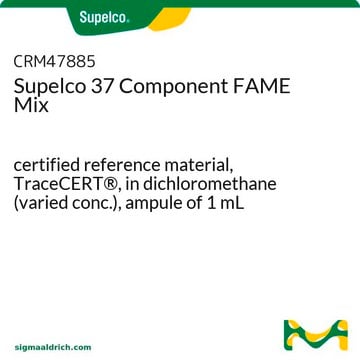P9667
Methyl palmitoleate
≥99% (capillary GC), liquid
Sinónimos:
Methyl cis-9-hexadecenoate, Palmitoleic acid methyl ester
About This Item
Productos recomendados
origen biológico
Macadamia integrifolia oil
Ensayo
≥99% (capillary GC)
Formulario
liquid
índice de refracción
n20/D 1.451 (lit.)
bp
180-183 °C/1 mmHg (lit.)
mp
−0.5-0.5 °C (lit.)
densidad
0.875 g/mL at 25 °C (lit.)
grupo funcional
ester
tipo de lípido
unsaturated FAs
Condiciones de envío
ambient
temp. de almacenamiento
−20°C
cadena SMILES
CCCCCC\C=C/CCCCCCCC(=O)OC
InChI
1S/C17H32O2/c1-3-4-5-6-7-8-9-10-11-12-13-14-15-16-17(18)19-2/h8-9H,3-7,10-16H2,1-2H3/b9-8-
Clave InChI
IZFGRAGOVZCUFB-HJWRWDBZSA-N
¿Está buscando productos similares? Visita Guía de comparación de productos
Aplicación
- Bioprospection of the Antarctic Diatoms Craspedostauros ineffabilis IMA082A and Craspedostauros zucchelli IMA088A.: This study investigates the bioprospective potential of Antarctic diatoms, identifying bioactive compounds including methyl palmitoleate that could be used in pharmaceuticals and nutraceuticals (Trentin et al., 2024).
Envase
Código de clase de almacenamiento
10 - Combustible liquids
Clase de riesgo para el agua (WGK)
WGK 1
Punto de inflamabilidad (°F)
235.4 °F - closed cup
Punto de inflamabilidad (°C)
113.0 °C - closed cup
Equipo de protección personal
Eyeshields, Gloves, type ABEK (EN14387) respirator filter
Elija entre una de las versiones más recientes:
Certificados de análisis (COA)
¿No ve la versión correcta?
Si necesita una versión concreta, puede buscar un certificado específico por el número de lote.
¿Ya tiene este producto?
Encuentre la documentación para los productos que ha comprado recientemente en la Biblioteca de documentos.
Los clientes también vieron
Protocolos
Protocol for GC Analysis of Bacterial Acid Methyl Esters (BAMEs) on Equity®-1
Nuestro equipo de científicos tiene experiencia en todas las áreas de investigación: Ciencias de la vida, Ciencia de los materiales, Síntesis química, Cromatografía, Analítica y muchas otras.
Póngase en contacto con el Servicio técnico











